Dan Benardot, Ph.D., DHC, R.D., L.D., FACSM |
Jan.
25, 2021
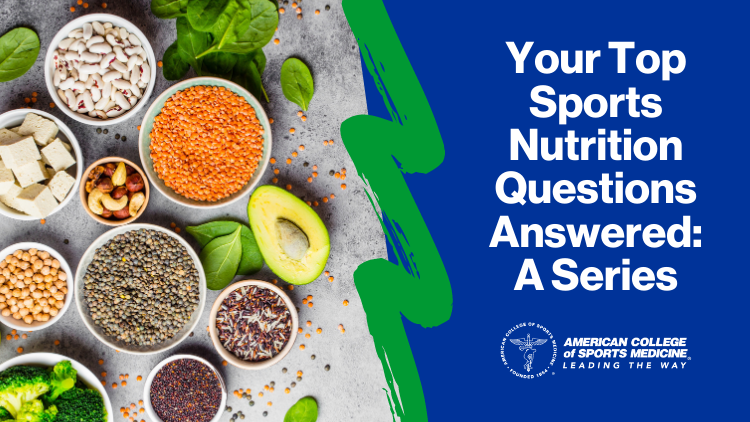
3 Nutrition FAQs from the webinar - Nutrition and Physical Activity: The Science Works
This part of the FAQ series covers: nutrient ratios for strength training, iron and older adults.
Watch the Webinar on the Professional Resources Page
Not a Member? Join Today!
Q7: Is there any relationship between low iron, persistent, now being treated with oral supplements, with low bone mass?
I am unaware of any specific studies demonstrating a relationship between oral iron supplementation resulting in lower bone mineral density (BMD) in athletes. One study (Harris et al., 2003), found that the impact of iron on BMD was dose and calcium intake dependent. Another study (Yang et al., 2011) found that increased iron could be a factor that slows bone formation in postmenopausal women.
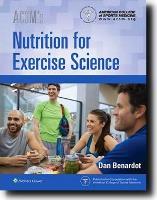
Download Sample Now
Data from the National Health and Nutrition Examination Survey, 2005-2010 found that higher serum ferritin (i.e., stored iron) was significantly associated with lower femoral neck and lumbar spine BMD. (Lu et al., 2020) There are also studies implying that common supplementation strategies of iron may have negative health consequences, with the recommendation that iron supplementation only be undertaken under the supervision of a physician and only prescribed when there is a known biological deficiency. For instance, Zoller and Vogel (2004), conclude that there is an increased risk for colon cancer and other conditions that mandate careful monitoring of athletes taking daily oral iron supplements.
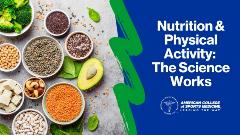
View Nutrition FAQs on fasting, adaptation timing and glycogen.
A study by Mursu et al (2011) of 38,772 older women (mean age 62 years) found that those who regularly took iron supplements had a 3.9% increase in all-cause mortality. It is my opinion that there is logic to assessing any potential relationship with iron supplementation and BMD, as both iron and calcium are divalent minerals that are competitively absorbed in the proximal duodenum. A daily high dose oral supplement of iron has the potential, therefore, of diminishing the absorption of calcium sufficiently to negatively impact BMD.
- Harris MM, Houtkooper LB, Sanford VA, et al. Dietary iron is associated with bone mineral densityin healthy postmenopausal women. J. Nutr. 2003; 133: 3598–3602
- Heinz Zoller, Wolfgang Vogel, Iron supplementation in athletes—first do no harm, Nutrition. 2004; 20(7-8): 615-619.
- Lu M, Liu Y, Shao M et al. Associations of iron intake, serum iron and serum ferritin with bone mineral density in women: The National Health and Nutrition Examination Survey, 2005-2010. Calcified Tissue International 2020; 106: 232-238.
- Mursu J, Robien K, Harnack LJ, Park K, and Jacobs DR. Dietary supplements and mortality rate in older women: The Iowa Women’s Health Study. Archives of Internal Medicine 2011; 171(18): 1625-1633.
- Yang Q, Jian J, Abramson SB and Huang X. Inhibitory effects of iron on bone morphogenetic protein 2–induced osteoblastogenesis. J Bone Miner Res, 2011; 26: 1188-1196. https://doi.org/10.1002/jbmr.337
Q8: I have some questions specifically for the older client. Where I can find more research on this information?
- How should post-menopausal women adjust their intake to support optimal bone health?
- How can recreational athletes who participate in activities that are 2-3 hours long, such as long bike rides, support their energy output. They are not competing, just riding long distances.
- How does intermittent fasting affect the older recreational athlete?
- I typically do not recommend sports drinks because they contain a lot of added sugar. Instead, I recommend my clients drink water and eat real food. If it's packaged food (easier to carry on a bicycle) the ingredients should be recognizable. Is this adequate?
It is my impression that the biggest factor for all of your bullets is to avoid relative energy deficiency in sport (RED-S). This requires planning to assure the activity takes place when the individual is in a relatively good energy balanced state, and that blood sugar is within the normal range. The individual should also plan on having a sports beverage available to sip on so as to sustain blood sugar within the normal range during the activity. This helps to lower cortisol, which is catabolic to lean and skeletal tissue. References on RED-S are provided below.
Note: A well-prepared sports beverage has about half the sugar content of orange juice per equal volume. Learning to sip on it rather than drink a large volume post-exercise or when thirsty is an important and effective strategy that has better outcomes than water when consumed during physical activity. I fully agree with you that liquid calories should be avoided when not exercising.
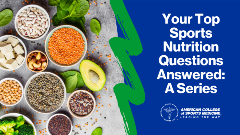
View Nutrition FAQs on Recovery Ratios Intermittent Fasting and more.
The result of intermittent fasting is to create a state of relative energy deficiency, so it is important to carefully review the International Olympic Committee consensus statements on the health and performance issues created with Relative Energy Deficiency in Sport (RED-S). These references, as IOC consensus statements, are publicly available (suggest doing a Google Scholar search for ‘Mountjoy RED-S’) to download and review. Here are some references related to RED-S:
- Mountjoy M, Sundgot-Borgen JK, Burke LM, et al. IOC Consensus Statement on Relative Energy Deficiency in Sport (RED-S) Br J Sports Med. doi:10.1136/ bjsports-2018-099193
- Torstveit MK, Fahrenholtz I, Stenqvist TB, Sylta O, and Melin A. Within-Day Energy Deficiency and Metabolic Perturbation in Male Endurance Athletes. Int J Sport Nutr Exerc Metab. 2018; 28: 419-427
- Fahrenholtz IL, Sjödin A, Benardot D, et al. Within-Day Energy Deficiency and Reproductive Function in Female Endurance Athletes. Scand J Med Sci Sports 2018; 1-8: DOI: 10.111/sms.13030.
- Delk-Licata A, Behrens CE, Benardot D, et al. The Association Between Dietary Protein Intake Frequency, Amount, and State of Energy Balance on Body Composition in a Women’s Collegiate Soccer Team. Int J Sports Exerc Med 2019; 5(3):123. DOI:https://doi.org/10.23937/2469-5718/1510123
These papers and the book (ACSM’s Nutrition for Exercise Science) clearly describe the health and performance issues created when there is insufficient energy available to perform the physical task at hand. While there may be a temporary ‘weight’ loss, the elevation in cortisol suggests that far too much of the weight is coming from lean tissue, which compromises the very tissue the athlete is trying to improve through exercise. In addition, cortisol is highly catabolic to bone tissue, placing the athlete at higher risk of skeletal injury (stress fracture, etc.). It is important to consider that blood sugar maintenance during the day with normal daytime activity is approximately 3 hours, and at night while asleep approximately 7 hours. Exercising when in a low blood sugar state, as these papers clearly describe, creates precisely the opposite outcomes to what the athlete is wishing to achieve.
Chapter 10 of ACSM’s Nutrition for Exercise Science is devoted to reviewing what we know about optimizing nutrition strategies for different ages and sex. The focus on older athletes are the following health-related issues:
- Age-related changes in body composition and the impact this has on REE;
- Lowered capacity to quickly recover from intensive or long bouts of exercise;
- Gradually diminishing bone mass;
- Subtle changes in GI tract function that could influence nutrient absorption;
- Progressively lower heat tolerance;
- Progressive decreases in the glomerular filtration rate and renal blood flow;
- Reduced capacity to concentrating urine, increasing urinary frequency, and, potentially, lowering fluid consumption.
Thank you for asking these important questions.
Q9: Based on the presenter’s previous work and also previous research that I have read, I have come to accept 3:1 to 4:1 as the optimal carbohydrate to protein ratio for immediate post-workout glycogen replenishment. But in the presentation on 19 November a 1:1 carbohydrate to protein ratio was presented. Is this based on updated research or has something else changed. I am particularly interested in glycogen replenishment after intense resistance training for hypertrophy (or strength) with, for example, a duration of less than 60 minutes 3-4 days per week and assuming an optimal (surplus) calorie intake and 55-60% carbohydrate, 18-20% protein and 20-25% fat.
Apologies for having left his impression. The key point to consider is that there is evidence that both carbohydrate and protein consumption post exercise are important. The general recommendation is that more carbohydrate (g/kg) should be consumed post exercise than protein, but the data on the specific ratio are, as yet, categorized as only ‘fair’ or ‘limited’ (see reference below: Thomas et al., 2016). It has been summarized from these studies that consuming about 20 to 30 g protein, or ~10g of essential amino acids post-exercise results in increased whole body and muscle protein synthesis as well as improved nitrogen balance.
Please note the large range in the recommendation (i.e., 20 to 30 g). It has also been found that co-ingestion of carbohydrate with protein found no significant improvement on muscle glycogen synthesis, as this is primarily a carbohydrate only factor. It has been determined that the highest rate of muscle glycogen synthesis occurs when large amounts of carbohydrate (1.0–1.85 g/kg/h) are consumed immediately post-exercise and at 15-minute intervals thereafter, for up to 5 hours post-exercise. (Please note the range in carbohydrate recommendation.)
The total daily recommended protein intake is approximately the same (1.2 to 2.0 g/kg/d) as the post-exercise hourly intake of carbohydrate, suggesting that post-exercise carbohydrate needs are significantly higher post exercise. To put this into relative perspective, the recommendation for 30 g of protein post exercise for a 150 lb (68 kg) athlete represents about 0.44 g/kg protein, with the recommendation for carbohydrate significantly higher. These data also suggest differential effects, with protein consumption focusing primarily on muscle soreness and recovery, with carbohydrate consumption focusing primarily on glycogen recovery.
Clearly, athletes need carbohydrate, protein, and fluids post exercise, and the judgement on the relative amount provided should be based on the degree to which glycogen depletion and muscle soreness have occurred, which are factors likely related to exercise duration and intensity, and fluid volume/quality consumed during exercise.
As a side note, since energy balance is likely to be low post exercise, a relatively high protein and low carbohydrate intake post-exercise is likely to result in at least a portion of the protein being used to satisfy energy recovery needs. As this can only occur when protein is denitrogenated, the resultant higher blood urea nitrogen is likely to result in higher urine production and inhibit a speedier return to a well-hydrated state.
Thomas DT, Erdman KA, Burke LM. American College of Sports Medicine Joint Position Statement: nutrition and athletic performance. Med Sci Sports Exerc. 2016;48(3):543–68.
Explore More Popular Nutrition Content
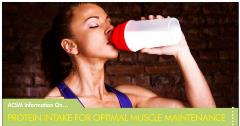
How Much Protein for Muscle | Repair, Growth, Maintenance
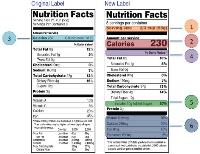
What You Need to Know About the New Food Nutrition Label
Presenter:
ACSM Fellow Dan Benardot, Ph.D., DHC, R.D., L.D., is Professor Emeritus at Georgia State University, and Professor of Practice in the Center for the Study of Human Health at Emory University. He is the author of the popular book ACSM’s Nutrition for Exercise Science.